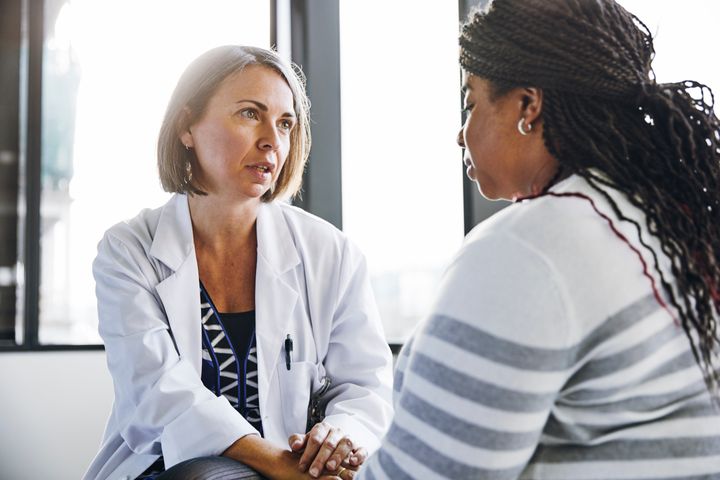Breast cancer is a scary reality for many women and a fear for many more. While certain risk factors ― such as having a family history of the disease or the BRCA1 gene mutation ― are well-known, others fly dangerously under the radar.
One risk factor that affects nearly half of women in the United States is having dense breasts, which you may not know you have until you get your first mammogram.
Until now, health care providers were not mandated to share breast density information with their patients. Instead, guidance varied from state to state. But as part of a Food and Drug Administration-approved update to the Mammography Quality Standards Act, healthcare providers must now inform patients of their breast density and explicitly state the risks that come with dense breast tissue.
There are two main reasons why breast tissue density is important, Dr. Kimberly Feigin, interim chief of the Breast Imaging Service at Memorial Sloan Kettering Cancer Center in New York, told HuffPost via email.
“The first reason is that women with dense breasts have a higher risk of developing breast cancer than women with non-dense breasts,” she said.
“The second reason is that screening mammography is less sensitive for detecting breast cancer in dense breasts. This is because breast cancer, which typically looks white on a mammogram, can be ‘masked’ (hidden or obscured) on a mammogram by dense breast tissue, which also looks white on a mammogram,” Feigin added.
Breast density is not something you can change; it’s just your anatomy. Additionally, you won’t know you have dense breasts until a screening is performed and a medical professional tells you.
“It is not something that you can feel or know or detect on your own,” said Dr. Arif Kamal, chief patient officer for the American Cancer Society. “In it of itself, it is not an abnormality.”
Mammogram patients with dense breast tissue will now get a statement following their results that reads: “Your breast tissue is dense. In some people with dense tissue, other imaging tests in addition to a mammogram may help find cancers. Talk to your healthcare provider about breast density, risks for breast cancer, and your individual situation.”
And it’s fairly likely that you’ll end up seeing this message on your next mammogram paperwork. According to Kamal, “Forty percent of mammograms demonstrate dense breast tissue, and we know that that increases the risk of breast cancer by one-and-a-half to twofold.”
There are two categories of dense breasts: heterogeneously dense and extremely dense, according to Dr. Wendie Berg, a professor of radiology at the University of Pittsburgh School of Medicine and the chief scientific advisor for Dense Breast-Info.
“Heterogeneously dense [tissue], much more common, [is] just patchy areas where there’s glandular tissue, and cancers can be hidden in those areas. Extremely dense [breasts] just absorb the X-rays more, and it makes the mammogram look white, and cancers are also white, and so we just have a hard time seeing them through the denser tissue,” Berg said.
In some states, your specific density category is required to be on your mammogram results letter, but that is not a nationwide mandate, according to Berg. But this information is required to be in your medical history, so you can ask your doctor if you have heterogeneously dense or extremely dense breasts. Since cancer is even harder to see in those with extremely dense breasts, it’s important to know where you fall.
Breast cancer is the most common cancer in women in the United States next to skin cancers, so all this might be pretty unnerving. But knowing more about breast density will help you better understand your cancer risk and allow you to take extra steps to protect yourself.
Below, doctors share what you can do if you find out you have dense breasts:
Chat with your doctor about your lifetime risk of developing breast cancer.
Dense breast tissue is a risk in itself for developing breast cancer and for missing the cancer altogether on mammograms, according to Berg.
There are many other risk factors that are important to weigh, too. Your doctor should be able to help you calculate your lifetime risk of developing breast cancer using one of several risk models, Berg said.
These models consider factors like your breast density, weight, height, any history of cancer in your family, the age you started or stopped having periods and your breast biopsy history.
Most patients get put into one of two categories, Kamal said: An “average risk” person has a less than 20% chance of getting breast cancer in the next five to 10 years, while a “high-risk” patient would face a risk of 20% or higher.
A high-risk patient could benefit from “something different from the usual guidelines” for mammograms, Kamal said, like getting a repeat mammogram every 12 months ― though exactly what people at high risk should be doing varies depending on who you ask.
“The challenge is, in some ways, the guidelines haven’t really caught up yet to what that would be, and so there is a difference of opinion among scientists about what to do next,” Kamal added.
Your breast cancer screenings may need to be more frequent.
Your doctor may recommend more frequent mammograms — like every six months instead of every year — and may also prescribe additional screenings like breast ultrasounds or 3D mammography.
These additional screenings do not replace your annual mammogram.
“It is important still to get your mammogram, it does find a few things that we don’t find on an MRI. … We do get a look at a lot of things, and we do find a good number of cancers,” Berg said. “It’s just that there’s more to it than that, and it’s important to be aware of that and to not be lulled into a false sense that everything’s fine.”

The Good Brigade via Getty Images
MRIs are an option, too.
MRIs find roughly three times more cancers than mammograms, according to Berg, which make them a powerful tool for many people with a high risk of breast cancer. That includes people with certain gene mutations, a history of radiation treatment to the chest or folks with a breast cancer lifetime risk that’s higher than 20%.
“MRI is a lot better [than a mammogram and even other screening methods] if the woman has dense breasts or meets other risk criteria,” Berg said.
You can talk to your doctor about this possible screening tool, as you’ll need a referral ― but know that MRIs are not always covered by insurance, said Berg. If your breast MRI is not covered, there are still options.
“There also are centers that offer so-called abbreviated MRI, [and] some of those are direct-to-patient and self-pay situations,” Berg said. Costs range from roughly $250 to $650. Berg recommended using Time To Be Seen, an abbreviated MRI database, to find a center near you.
According to Susan G. Komen, breast MRIs result in false positives more often than mammograms, which may mean they spur unnecessary biopsies or follow-up tests. For some people, this could be a reason not to get a breast MRI, but for others, it’s just a necessary step to ensure they’re cancer-free — and it’s up to you to make that call.
You may want to consider genetic testing.
Cancer-causing mutations can be found via genetic testing. Some of those mutations can mean your breast cancer screenings either should start earlier than the recommended age of 40, or mean that you’d be eligible for additional screenings like MRIs, according to Berg.
Even without the genetic mutations, other factors could be reason enough to start testing earlier. “One informal rule that’s out there is to start screening 10 years before the age of diagnosis of a first-degree relative,” Berg said. “So, let’s say [your] mom was diagnosed at 45 — you should start screening at 35.”
You should advocate for yourself, whether you have dense breasts or not.
“When you talk to your doctor [about having dense breasts], I wouldn’t allow inaction, and what I mean by that is, I don’t think there’s a reasonable response where a doctor says, ‘Oh, yeah, there’s nothing to do about that.’ I don’t think that’s the right answer,” Kamal said.
Of course, patients who don’t have dense breasts should still advocate for themselves, especially if they have a family or personal history of cancer or gene mutations like BRCA1 or BRCA2.
You know your body, personal history and family history best; if something gives you pause when it comes to your health, you should let your doctor know ASAP.
“What’s going to help you have peace of mind? I think, fundamentally, that’s what we’re after,” Kamal said.


